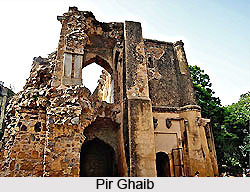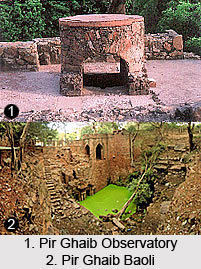 Pir Ghaib meaning "Vanishing Saint" is located in the heart of the northern ridge of Delhi. It had been built in 1630 AD by Feroz Shah Tughlaq. Pir Ghaib lies southwest of Chauburji Masjid in the grounds of Hindu Rao Hospital. It is rubble built double storey structure, with the remains of a "Baoli" or step well. The monument has been so named after a saint suddenly disappeared while meditating at the cenotaph in the northern apartment of the monument. It has been built either as a Kushk-I-Shikar (hunting lodge) or Kushk-I-Jahan-Numa (world showing palace).
Pir Ghaib meaning "Vanishing Saint" is located in the heart of the northern ridge of Delhi. It had been built in 1630 AD by Feroz Shah Tughlaq. Pir Ghaib lies southwest of Chauburji Masjid in the grounds of Hindu Rao Hospital. It is rubble built double storey structure, with the remains of a "Baoli" or step well. The monument has been so named after a saint suddenly disappeared while meditating at the cenotaph in the northern apartment of the monument. It has been built either as a Kushk-I-Shikar (hunting lodge) or Kushk-I-Jahan-Numa (world showing palace).
It used to be a small palace at one point of time. It was probably built as a hunting lodge in the 14th century as back in those days there was nothing but a jungle in this area. Even now, this forms one corner for the Kamala Nehru Ridge, one of the major forest covered areas that helps Delhi breathe. The building is partially ruined, probably because it saw substantial action during the mutiny of 1857.
History of Pir Ghaib
Pir Ghaib had also served as an important place during the siege of Delhi in 1857. The ridge had been under the control of the citizens of Delhi and the Sepoys from the 11th of May to early June. Later after the "Badli ka Serai" battle was over the ridge was deserted. It was then occupied by the British officials and used as an outpost. There is a lane behind the observatory that was employed for firing and had been termed as the "Valley of Death" by the British soldiers. The Pir Ghaib monument had been well defined as an observatory by the British.
Architecture of Pir Ghaib
Pir Ghaib is rich in architectural design. A cylindrical pillar or the Zenith Tube can be seen emerging vertically out of the roof of the monument. The upper surface of the cylindrical pillar is believed to have been used as a dial for measuring the azimuth of the Sun or the Moon. It is done by inserting a vertical pole into the small hole at the centre of the circular disk covering the topmost surface of the pillar.
 There are openings close to the floor of the of the roof observatory. These are believed to have been either air vents or used for communicating by the observers sitting on the roof and in the room below. From this room, looking up into the hole in the cylindrical tube on the roof, one could observe the passing of stars that are exactly overhead at any given moment. The most interesting part of the observatory is that this is the only Zenith Tube in the world that was used to study the maximum northward swing of the Moon, during Major Lunar Stand still years.
There are openings close to the floor of the of the roof observatory. These are believed to have been either air vents or used for communicating by the observers sitting on the roof and in the room below. From this room, looking up into the hole in the cylindrical tube on the roof, one could observe the passing of stars that are exactly overhead at any given moment. The most interesting part of the observatory is that this is the only Zenith Tube in the world that was used to study the maximum northward swing of the Moon, during Major Lunar Stand still years.
The Pir Ghaib observatory has been graded as Archaeological Value A in Delhi the Built Heritage: "A Listing" by the Indian National Trust for Art and Cultural Heritage (INTACH).
Current Scenario
At present, the monument is in an appalling state. The building is now protected with iron grills but there is a little maintenance found inside. The ground floor as well as on the first floor has two chambers giving access from the east and west, and two rooms on the north and south. There are two rooms on the second storey with openings on the east and minhrabs in the western wall, with pious exclamations incised above them on plaster. They appear to have been used as a mosque. It is believed by few people that earlier Pir Ghaib served as an astronomical observatory because a hollow masonry cylinder perforates the floor and the roof of the southern apartment of the monument. However, it is not exactly known.
In the vicinity of the observatory one can see the remains of the Baoli. It was once a part of the palace and was the main source of water for the area. The Baoli cannot be seen today and one can only imagine the existence by seeing the impression on the ground and a portion of arched construction in stone.



















